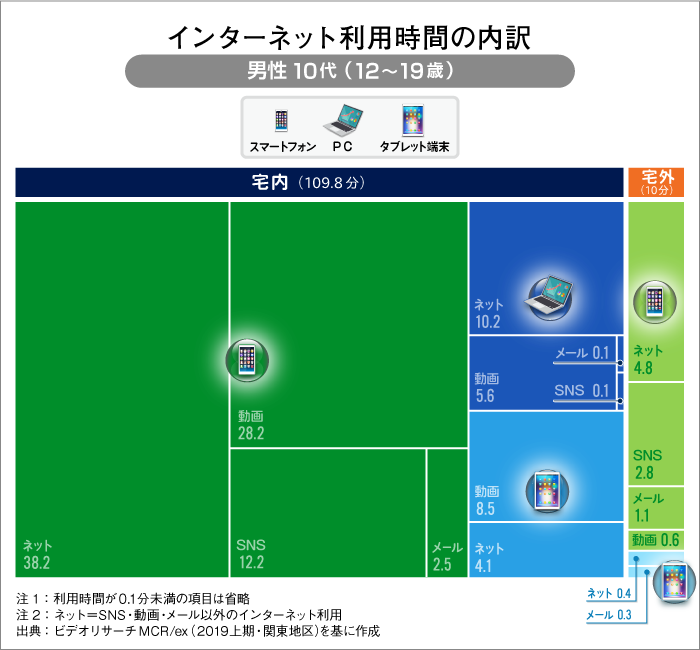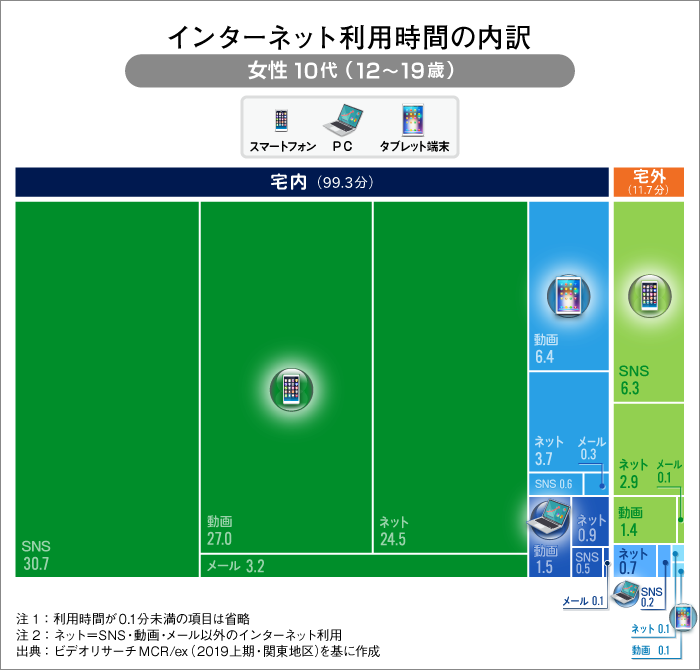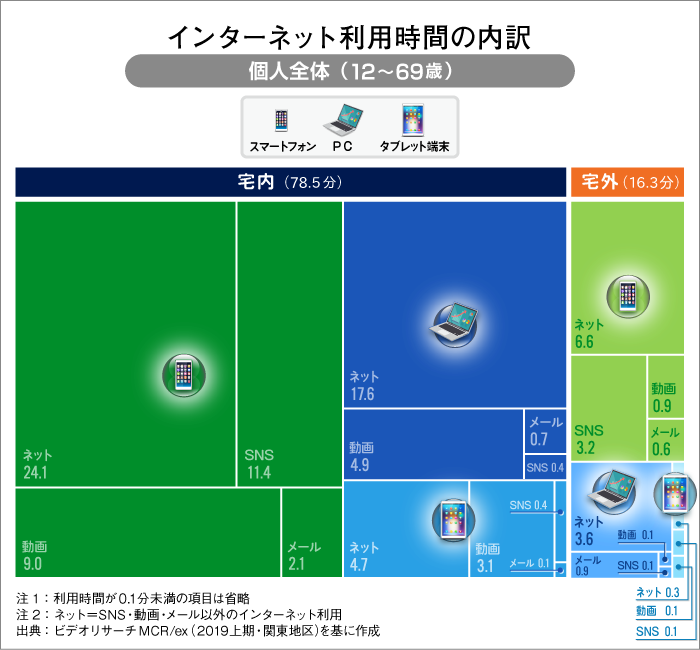Following Part 1, we now consider internet usage scenarios from Part 1 of the opening feature, "The Role of Media and Audiences in the Reiwa 'New' Era," in the Dentsu Inc. Media Innovation Lab's 'Information Media White Paper 2020' (published by Diamond Inc.).
Generally, the advantage of the internet is that, with a network connection and a device, you can access various services anytime, anywhere. Indeed, opportunities to use the internet on smartphones during brief moments while out and about or riding the train are likely frequent.
Because of its "anytime, anywhere" nature, we tend to think the internet is frequently used outside the home. But where and how is it actually being used? Let's examine this based on Video Research Ltd.'s MCR/ex(※) data (first half of 2019, Kanto region).
※=MCR/ex
A database recording the 24-hour daily activities and media consumption of survey participants in 15-minute intervals over a specific week (7 days) in a diary format.
Internet Use is Mainly "Inside the Home" and "via Smartphone"
Figure 1 shows the average weekly daily internet usage time for "all individuals" (ages 12-69), broken down by location (home/outside home) and by service usage time per device (smartphone, PC, tablet).
[Figure 1]

For the "Overall Population," 94.8 minutes per day are spent using the internet. Of this, 78.5 minutes occur at home and 16.3 minutes outside the home. While the internet can be used "anywhere," 82.8% of internet usage still takes place at home.
The reason usage outside the home falls short of 20% likely stems from the difficulty of finding extended periods of time while out and about, coupled with concerns about exceeding mobile data plans, which tend to curb usage.
Next, looking at internet usage by device, smartphones are the most common, accounting for 46.7 minutes at home and 11.3 minutes outside the home. The trend that smartphones dominate the majority of internet time spent outside the home (16.3 minutes) probably doesn't feel too surprising when compared to your own or others' daily habits.
On the other hand, what about the finding that smartphones account for about 60% of internet usage time even at home? Those with access to PCs or tablets at home might find this ratio somewhat high. However, the survey data clearly shows that the majority of internet usage occurs "at home" and is done "via smartphone."
Younger age groups use the internet more at home
Looking at the same data by user age reveals even more interesting trends.
One might assume younger generations, being students or young professionals with active lifestyles, would spend more time online outside the home. However, looking at internet usage time for male teens (12-19 years old), for example, it's 109.8 minutes at home versus 10.0 minutes outside the home. This means 91.7% of their internet usage occurs at home. This is an exceptionally high ratio compared to the overall individual average of 82.8% (Figure 2).
[Figure 2]

For female teens (12-19 years old), usage is 99.3 minutes at home and 11.7 minutes outside the home, showing a similarly high tendency for home usage at 89.4% (Figure 3).
[Figure 3]

The age group spending the most time online was those in their 20s (men: 183.4 minutes, women: 141.6 minutes). However, their home usage ratio was only slightly higher than the overall individual average, at 83.9% for men and 83.3% for women.
This survey reveals that it is not young people but working-age men who actively use the internet outside the home. The highest proportion of usage outside the home was among men in their 30s to 50s, with approximately 25% of their total internet time spent outside the home.
Middle-aged and older adults show high affinity with PCs
Focusing on devices used at home reveals a unique trend among men in their 50s and 60s. For men in their 50s, out of 68.1 minutes of home internet time, 34.5 minutes were via PC (Figure 4). For men in their 60s, 50.7 minutes out of 69.0 minutes were via PC. The PC is the top device for internet usage time at home only among men in their 50s and 60s across all age groups.
[Figure 4]

Looking back, this age group entered the era of PC proliferation, which began with the arrival of Windows 95, as university students or young working adults. Subsequently, they spent a long period using PCs professionally as working adults, making them the generation most proficient with PCs.
While smartphones are the primary device for internet use at home among women in their 50s and 60s, their PC usage ratio remains higher compared to those in their 40s and younger.
Younger men use online videos more, while women use SNS more
Finally, let's examine what activities people engage in online at home. When combining usage time across three devices by service type, the overall average for individuals is: general internet (excluding SNS, videos, and email) 46.4 minutes, online videos 17.0 minutes, and SNS 12.2 minutes.
[Figure 1]

While the first installment touched on the strong affinity between younger generations and online videos, this data confirms the same trend. The group spending the most time on online videos at home is men in their 20s (55.6 minutes total across three devices), followed by men in their teens (42.2 minutes), women in their teens (34.9 minutes), and women in their 20s (29.1 minutes).
While we refer to them collectively as young people, males are more actively watching online videos, while females tend to spend more time on SNS. For example, in Figure 3 for females in their teens, SNS ranks as the top service used via smartphones at home, surpassing video viewing.
[Figure 3]

Looking at total SNS usage time at home across all three devices for women, teens averaged 31.8 minutes, women in their 20s averaged 38.2 minutes, and women in their 30s averaged 20.0 minutes. For women, SNS usage exceeded online video usage across nearly all age groups (20s to 50s). In contrast, no age group of men showed SNS usage at home exceeding online video usage.
This detailed analysis suggests that generation-specific experiences and affinity for individual services are reflected in internet usage patterns. Overall, however, it appears that internet use at home predominantly occurs via smartphones. Next time, we will examine in detail how these smartphones are being used.








